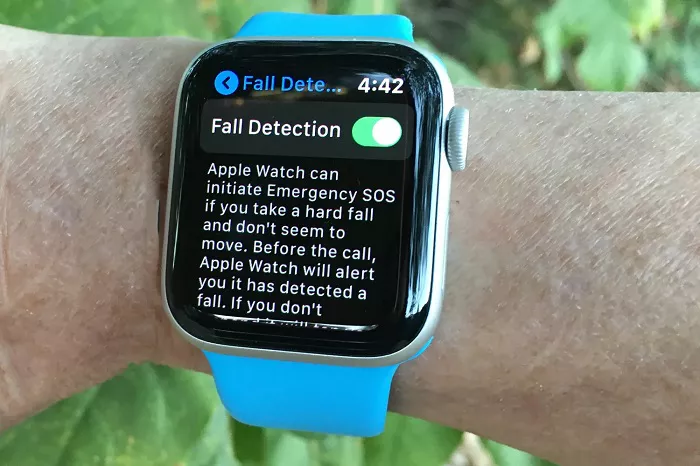The Apple Watch includes a safety feature called Fall Detection. This feature is designed to help users who experience a hard fall by automatically sensing the event and offering assistance. When the watch detects a fall, it alerts the wearer with a notification and vibrates on the wrist. If the wearer remains still or unresponsive after the fall, the watch can automatically contact emergency services.
How Does Fall Detection Work?
Fall Detection uses built-in motion sensors such as the accelerometer and gyroscope. These sensors analyze sudden changes in movement and impact to determine if a hard fall has occurred. When a fall is detected, the watch shows an alert. The user can respond by choosing to call emergency services, dismiss the alert, or indicate that they are okay.
If the watch senses no movement for about a minute after the fall alert, it assumes the wearer may need help. It will then automatically place a call to emergency services and send a message to emergency contacts with the wearer’s location.
Which Apple Watch Alerts if You Fall?
Fall Detection is not available on all Apple Watch models. It was first introduced with the Apple Watch Series 4. Since then, every new series has included this feature as part of its health and safety suite. Specifically, the following models support Fall Detection:
- Apple Watch Series 4
- Apple Watch Series 5
- Apple Watch Series 6
- Apple Watch Series 7
- Apple Watch Series 8
- Apple Watch SE (2nd generation and later)
- Apple Watch Ultra
This means if you own an Apple Watch Series 3 or earlier, this feature will not be available. For users who want advanced safety features, including fall alerts, upgrading to one of the newer Apple Watch Series or the Apple Watch Ultra is recommended.
How to Enable Fall Detection on Your Apple Watch
Fall Detection is not always turned on by default. Here is how you can enable it:
- Open the Watch app on your paired iPhone.
- Tap on Emergency SOS.
- Scroll down and find the option for Fall Detection.
- Toggle the switch to enable Fall Detection.
Once enabled, the Apple Watch will continuously monitor for signs of a fall. If it detects a hard fall, it will activate the alert system automatically.
When Does the Apple Watch Alert You After a Fall?
When the watch detects a fall, it vibrates and sounds an alarm to get your attention. A message will appear on the screen asking if you are okay. You have several options:
- Tap I’m OK to dismiss the alert.
- Tap Call Emergency Services to get immediate help.
- Ignore the alert. If no response is detected after about one minute, the watch will assume you need help and will call emergency services automatically.
This system is designed to protect users who may be unconscious or unable to respond after a fall.
How Accurate Is the Fall Detection Feature?
The Fall Detection feature is highly advanced but not perfect. It is optimized for users over 55 years old, as they are at higher risk of falls. For younger users, the feature can sometimes produce false alarms during vigorous activities like sports or jumping.
To reduce false alerts, the watch uses complex algorithms that analyze motion patterns and impact forces. If a false alarm occurs, you can simply dismiss the alert. However, it is always better to have the feature on if you have any concerns about your safety.
Benefits of Fall Detection for Older Adults and Active Users
For older adults, fall detection is a critical safety tool. Falls can lead to serious injuries, and immediate medical attention can be lifesaving. The Apple Watch’s ability to automatically call for help when the wearer is unresponsive adds a layer of security and peace of mind for both the user and their loved ones.
Active users such as hikers, runners, or cyclists also benefit from this feature, especially in remote areas where help may not be immediately available. The Apple Watch Ultra, designed for extreme sports and outdoor activities, includes this feature and is tailored to withstand rugged conditions while keeping users safe.
What Happens When Emergency Services Are Called?
When the Apple Watch calls emergency services after detecting a fall, it automatically shares your current location. It also sends an alert to your emergency contacts with a message that you may need help. This feature ensures that responders can find you quickly, even if you cannot communicate verbally.
Customizing Emergency Contacts and Alerts
You can add or edit emergency contacts in the Health app on your iPhone. These contacts will receive notifications if your Apple Watch calls emergency services due to a detected fall. Setting up these contacts is essential for the fall detection feature to work effectively.
To add emergency contacts:
- Open the Health app on your iPhone.
- Tap your profile picture, then tap Medical ID.
- Tap Edit, then scroll to Emergency Contacts.
- Add contacts and their relationship to you.
- Save your changes.
Limitations and Considerations
While the Apple Watch fall detection is impressive, it does have limitations:
- It may not detect very soft or gradual falls.
- False alarms can happen during certain physical activities.
- The feature requires a good fit on the wrist to function optimally.
- The watch needs to be worn consistently to provide protection.
Understanding these limits helps users set realistic expectations and use the device safely.
Conclusion
Fall Detection on the Apple Watch is a powerful safety feature that can provide life-saving assistance in emergencies. Available on all models from Series 4 onwards, including the rugged Apple Watch Ultra, it gives users and families peace of mind. Enabling and customizing the feature is simple and highly recommended, especially for older adults and active individuals.
Related Topics:
How to Get My Apple Watch off Airplane Mode: A Complete Guide

